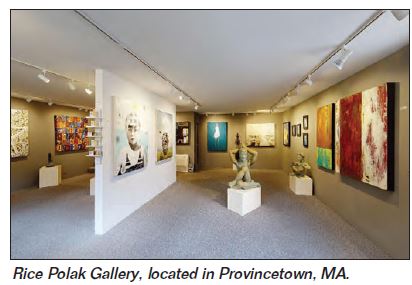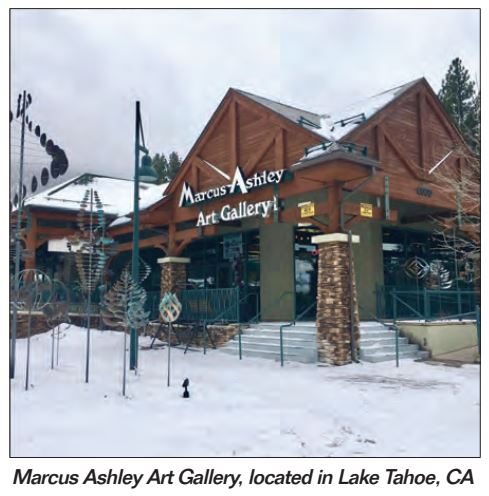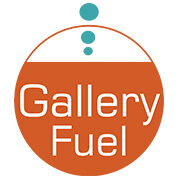I often contribute to Art World News and I wanted to share with you one of their articles about what art galleries can do to boost sales when tourist seasons close. This article was written by Koleen Kaffan, who is Editor in Chief of Art World News and offers some excellent insights that I hope will help you make the best decisions for your gallery business.
Summer in the art and framing industry can mean an influx of new sales. For those located in desirable destinations, it can mean even more opportunities to grow their customer base. But how do they turn vacationers into year-round sales prospects? According to Gallery Fuel’s Katherine Hébert, embracing technology is the key. “Art galleries in vacation destinations need to embrace the hybrid business model with equal emphasis on sales online and off,” she says. “Today there are so many digital tools to help make that possible, such as e-commerce, virtual exhibitions, artist talks on Zoom, etc., but the two most essential and even fundamental, in my opinion, are building a mailing list and using contact tags in the customer relationship management (CRM) software.”
We have seen the American tourism industry recover from the pandemic slowly, but it has been reported that only 25% of travelers say Covid-19 is affecting their vacation plans. This is a vast improvement on last year. In 2022, those polled said it factored into 50% of the equation. Many people are also opting to stay stateside. According to a recent study conducted by AARP, 61% of Americans say they are only taking domestic trips within the U.S., and most are opting to drive rather than fly.
With the U.S. being one of the most popular destinations for travelers, worldwide, the travel and tourism industry contributed nearly 900 billion U.S. dollars to the country’s gross domestic product (GDP) in 2021, according to Statista.
For fine art galleries and custom frame shops in destination locations, this means many opportunities to increase their sales, even out of season, if they adopt a hybrid model suggested by Ms. Hébert. At Gallery Fuel, a subscription-based service, she brings the experience of more than 25 years in the gallery business and provides expert advice, tools, and strategies for running a successful business, as well as personalized support.
A big component of the hybrid model is to gather as much information on a customer as that makes it easier to continue the conversation after they return home, wherever in the world that may be. “Being able to articulate the benefits of receiving a gallery newsletter is important,” she says. “Simply asking if they would like to be on a mailing list is not the most effective strategy. A gallery must be able to demonstrate the value that a prospective buyer can relate to.”
While some may be reluctant to give out personal information, gallery owners must offer a compelling reason for why continuing contact would interest them. “To stay in touch with gallery visitors in the off-season, it is critical to capture e-mail addresses to build the mailing list. That might mean getting creative with incentives, such as freebie information that could be e-mailed. This needs to be planned and brought up in conversation with vacationing visitors.
“Once on the list, add tags to their contact record so lists can be sorted and filtered in many ways to communicate in a more personalized way. An e-mail automation series could be a good strategy to stay top-of-mind and nurture the relationship long distance.”
According to the U.S. Bureau of Labor Statistics, the average number of paid vacation days is 11 to fifteen. Therefore, people like to make the most of this downtime and tend to spend more money than in their day-to-day lives. It is reported that in 2023, the average American adult plans to spend around $6,688 while on vacation. And revenue in the travel and tourism market is projected to reach $190.40 billion this year.
As Cape Cod, MA, has been a coveted vacation destination for many years, Provincetown located at the tip, sees an influx of vacationers with its gallery district, storied history, vast beaches and dunes, various restaurants, lively entertainment, and town-wide events. This small coastal resort town has a year-round population of just below 3,000, which grows to more than 60,000 in the summer.
 Marla Rice, director of Rice Polak Gallery, located on bustling Commercial Street in Provincetown, says that 75% of her yearly sales come from the summer months. Founded in 1992, the gallery takes part in the Provincetown Gallery Associations’ The Stroll which takes place Friday evenings in the summer and features special exhibitions. This helps to expose the gallery, and its artists, to new people with each event. Ms. Rice notes that 40% of those sales from visitors to the town are turned into repeat customers. Provincetown, itself, is a destination that visitors tend to come back to year after year, thus opening the door for more repeat customers. “We make sure to capture mailing and e-mail addresses of customers and send them annual mailings and bi-monthly e-mails keeping them appraised of new art and gallery happenings,” she says. “For our year-long local customers, we adopt the same strategy.”
Marla Rice, director of Rice Polak Gallery, located on bustling Commercial Street in Provincetown, says that 75% of her yearly sales come from the summer months. Founded in 1992, the gallery takes part in the Provincetown Gallery Associations’ The Stroll which takes place Friday evenings in the summer and features special exhibitions. This helps to expose the gallery, and its artists, to new people with each event. Ms. Rice notes that 40% of those sales from visitors to the town are turned into repeat customers. Provincetown, itself, is a destination that visitors tend to come back to year after year, thus opening the door for more repeat customers. “We make sure to capture mailing and e-mail addresses of customers and send them annual mailings and bi-monthly e-mails keeping them appraised of new art and gallery happenings,” she says. “For our year-long local customers, we adopt the same strategy.”
When it comes to marketing to the two groups of collectors, Ms. Rice says that she may offer a few more perks to those that live outside of the area. “The main difference is that, if needed, I can deliver the artwork to the collector to help facilitate a sale.”
Being on vacation tends to create a happier, more relaxed customer and this is also helpful in the sales process. “The main difference between sales to vacationers and those that are local tends to be that people on vacation are generally more relaxed and happier,” Ms. Rice says. “Couples are together and can ‘discover’ artwork with each other, which I find to be very important.”
On the other side of the country, areas like Lake Tahoe, CA, bring in many vacationers. Recently voted one of the best places in the U.S. to visit for 2023-2024 by U.S. News, the area is known for its clear water and alpine lake attracting year-round vacationers and offering resorts for summer and winter activities. The busiest months are March to May and from September to November. Each year, around 15 million people visit, many are attracted to the basin which consists of more than 80% of public land.
At Marcus Ashley Gallery in South Lake Tahoe, CA, co-owner Ashley Mattila says that she sees an equal amount of vacationers to year-round collectors, but that the sales can be very different. “Our sales are relatively close between locals and vacationers. We see more overall traffic from visitors to the area, however, they are often smaller items that are more easily brought on planes and in cars,” she says. “We do offer international shipping that helps accommodate larger scale art that people find while they are in our beautiful destination.” In business for 19 years, the 4,400-square-foot gallery is in the shopping district of the Heavenly Village. “Full-time residents of Lake Tahoe often come in and become part of our family here in the gallery and oftentimes find pieces that speak to them personally that they must have in their home. We can build relationships with all our collectors, and we love both sides of our clientele.”
 Keeping that relationship going using social media, email, etc. is how repeat sales are cultivated. “At least half of our tourism sales will become repeat sales,” she says. “Collectors return to our gallery as they hear about new releases from our artists from their respective art consultants or our marketing team. Once you have one piece of art by an artist in your home it’s common to decide you want more from them to complete your collection. Our year-long resident collectors are often drawn in over time from our large collection of wind sculptures in front of our location, or from our weekly events in the gallery. They also see our signage and sponsorship of various charities and organizations around town. This helps create a strong image for our gallery in the community and we hope people come in and say ‘hi.’”
Keeping that relationship going using social media, email, etc. is how repeat sales are cultivated. “At least half of our tourism sales will become repeat sales,” she says. “Collectors return to our gallery as they hear about new releases from our artists from their respective art consultants or our marketing team. Once you have one piece of art by an artist in your home it’s common to decide you want more from them to complete your collection. Our year-long resident collectors are often drawn in over time from our large collection of wind sculptures in front of our location, or from our weekly events in the gallery. They also see our signage and sponsorship of various charities and organizations around town. This helps create a strong image for our gallery in the community and we hope people come in and say ‘hi.’”
Ms. Mattila says that marketing-wise, locals and out-of-towners have access to the same material. The locals may be able to attend more events throughout the year, but those vacationers can see how active the gallery is in the off-season and get excited about new artwork for their next visit or a sale over the phone.
“Our marketing is no different between the two sets of collectors. We host weekly ‘Meet the Artist’ events where collectors can come into the gallery and meet the artists that they love. These events are exciting for both tourists and locals who are looking for something to do for the weekend. Our marketing endeavors also follow the same course when it comes to digital marketing. Both locals and tourists receive the same information and images.”
While Lake Tahoe sees many new people who come for skiing and other outdoor winter activities, summer brings in the most amount of vacationers. “Our busiest time of the year is definitely summer when people are out and about enjoying the fresh mountain air,” Ms. Mattila continues. “Business picks up starting around Memorial Day weekend and begins to slow down again around October. Then we pick up again for a second boost in visitors in winter when the ski resorts open back up.”
Being prepared as a gallery and/or frame shop for this influx of sales opportunities is vital to making the most out of these times. “Business in tourist destinations is highly based on having a great team and even better customer service. Across all aspects of our business, we try to ensure that we are a first stop on peoples’ way back into town. We want them to not only think of art as something to put on a wall to beautify their homes but also as something fun we get to experience together. We think of our collectors as part of our family and are always eager to see them whether they live down the street or across the country.”
Leaving a lasting impression on a person during a sale, and after, can be the key to seeing repeat business. And Ms. Hébert’s suggestion of adopting a hybrid business model can help maintain a business’s longevity. “I used to go to the Outer Banks of North Carolina a lot,” she says. “I bought several things from a gallery there. They never once asked for an e-mail address to keep in contact. But a jewelry store there with one-of-a-kind artist-made pieces made note of a ring that I liked but didn’t buy. It was unusual, and I like weird stuff. I had been back several times on multiple trips and knew it was still there. Years later, the owner offered me a special price in a very personalized e-mail, mentioning when I first saw the ring and our conversation. The owner clearly made notes in my contact record. That e-mail did it. I bought the ring. Guess which one of the two shops is still in business.
“Keeping sales going in the off-season just takes being proactive with the long-distance visitors and ensuring the digital experience with a gallery is positive,” Ms. Hébert concludes. “Communications can tap into the emotions of the art, but also the emotions of destination locations and the memories a prospective buyer likely made.”
Koleen Kaffan is Editor in Chief of Art World News.


Leave a Reply